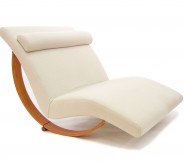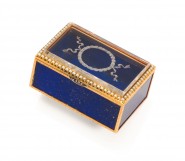Lot #17 - George Lambert
-
Auction House:Deutscher and Hackett
-
Sale Name:Two Important Private Collections: Modern / Traditional
-
Sale Date:08 Dec 2021 ~ 7pm (AEDT)
-
Lot #:17
-
Lot Description:George Lambert
(1873 - 1930)
Eyre And Wylie, 1908
oil on wood panel
26.5 x 38.0 cm
signed lower right: G. W. LAMBERT; inscribed on handwritten label attached verso: ‘Eyre the Explorer threatened by blacks who had murdered Baxter, Wylie (the aborigine) saved Eyre’s life'
Related Work/s: Burke and Wills on the way to Mount Hopeless, 1907, watercolour, 26.2 x 38.5 cm, in the collection of Bendigo Art Gallery, Victoria; An historical incident (a little white hero), 1907, pencil, watercolour and gouache, 30.5 x 41.9 cm, in the collection of the National Gallery of Victoria, Melbourne; Kate Kelly (during the last stand of the Kelly Gang), 1908, oil on canvas, 36.5 x 51.0 cm, private collection -
Provenance:Mrs. L. Abrahams, Melbourne, by 1918; George Page Cooper, Melbourne'; The Historical George Page Cooper Collection', Leonard Joel, Melbourne, 21 November 1967, lot 354; Private collection, Adelaide; Thence by descent; Private collection, Adelaide
-
Exhibited:Loan Exhibition of Australian Art', Art Gallery of New South Wales, Sydney, April 1918, cat. 71 (as ‘Eyre the Explorer’)'; Exhibition of Past Australian Painters Lent From Private South Australian Collections', Adelaide Festival of Arts, John Martin & Co. Limited, Adelaide, 8 – 29 March 1974, cat. 69 (label attached verso)'; George Washington Lambert', S.H Ervin Museum and Art Gallery, The National Trust of Australia, Sydney, 22 August – 8 October 1978, cat. 8
-
References:Lang, W. H., 'Romance of Empire: Australia,' T.C. & E.C. Jack, London, 1908, p. 164 (illus., as ‘Eyre and Wylie threatened by the murderers of Baxter’); Borlase, N., ‘A love of flamboyance’, 'Sydney Morning Herald', 2 September 1978, p. 17; Gray, A., 'George Lambert 1873–1930: Catalogue Raisonné: Paintings and Sculpture, Drawings in Public Collections', Bonamy Press, Perth, Sotheby's Australia and Australian War Memorial, Canberra, 1996, cat. P88, p. 25
-
Notes:The epic saga of Edward Eyre and Wylie’s arduous crossing of the Nullarbor Plain in 1841 is almost operatic in its dimension. The two young men experienced tragedy, starvation, deprivation and drought, yet both made it alive to King George’s Sound in Western Australia having stumbled overland for nearly 600 miles (965 kilometres) from their start in South Australia. When W. D. Lang’s 'Romance of Empire: Australia 'was being planned in 1907, it was to be the first national history written for child readers; thus, it was a certainty that Eyre and Wylie would be included in the narrative. However, the editorial choice of George Lambert to provide illustrations was particularly inspired and ensured that an artist who loved the Australian outback, its people and its horses would be responsible for visualising many of the book’s exciting ‘Boys Own’ moments. 'Eyre and Wylie', 1908, captures a pivotal moment two months after departure when the explorers’ overseer was shot by two of the party’s younger members, who then abandoned Eyre and Wylie to their fate; and Lambert’s crisp draughtsmanship is on full display. When commissioned to work with Lang, the artist was already noted for his illustrations for 'The Bulletin 'from 1895, and for similar work in three books published by Angus and Robertson. After re-locating to London in 1902, he continued the practice with 'Cassell’s 'and 'Pall Mall 'magazines, and the following year, drew lively sketches for Alexander Wilberforce (A. W.) Jose’s 'Two awheel: and some others afoot in Australia'. However, Jose’s writing suffered next to Lambert’s contributions with 'The Bulletin 'for one proclaiming that ‘the illustrations are more interesting than the book.’1 In 1907, he was invited to create twelve images to accompany the text in 'Romance of Empire: Australia', one in a new series of books exploring outposts of the British Commonwealth; other countries included Canada, India, West Africa, New Zealand and South Africa. Lambert’s illustrations were originally executed in watercolour and he chose to subsequently reproduce a small number of these of these in oils, including the lot on offer here. The description of Eyre and Wylie’s journey covers three chapters in 'Romance of Empire: Australia 'and was informed by the author reading Eyre’s own account, published in 1845, and Professor J.W. Gregory’s 'The dead heart of Australia: a journey around Lake Eyre in the summer of 1901-1902,' which appeared in 1906.2 In 1840, Eyre was still only twenty-five, yet had already gained notable attention for his entrepreneurship in driving stock from Sydney to South Australia, plus a sequence of explorations to the north of Adelaide. In January 1841, he commenced the attempt to cross the Nullarbor, and after a few stalled beginnings, Eyre sent most of the party back once they reached the head of the Great Australian Bight. His remaining companions were the overseer John Baxter; Wylie, a sixteen year-old Noongar man from the King George Sound district; and two younger boys, Neramberein and Cootachah, recorded as being from the Flinders Ranges.3 By mid-April, privations had set in sowing discontent, and on 29 April, disaster struck. Eyre had taken the first turn in watching the horses that night ‘and as it drew eleven he peered through the scrub to catch the glow of the camp fire, for Baxter’s watch began at that hour. Then suddenly, about a quarter of a mile away, there was a flash and the loud report of a gun.’4 Baxter was dead, shot by Neramberein or Cootachah who had apparently been disturbed by the overseer when they tried to steal supplies. Wylie chose to stay with Eyre in spite of repeated attempts over the next days by his former companions to entice him to join them; the two boys subsequently vanished. Lambert’s painting shows Eyre being menaced by the killers as Wylie cowers in his wake, an exaggerated stereotype rife in the Edwardian age. Even so, the artist has captured the high drama of the confrontation and vividly displays the physical privations endured by all the participants, horses included. Lambert has reduced the palette dramatically to monochromatic brown and grey reinforcing its emotive suggestion of a desperate moment in a desolate place. After many more struggles, the two men reached Albany where Wylie was greeted ecstatically by his people, who had believed him already dead. Of the twelve gouache and watercolour images which appeared in 'Romance of Empire: Australia', two are in the collections of the Bendigo Art Gallery and the National Gallery of Victoria. The two that Lambert chose to re-imagine in oil paint were 'Eyre and Wylie', and another of Ned Kelly’s sister Kate appealing to police at Glenrowan, location unknown. 1. ‘The red page: newly published’, 'The Bulletin', vol.24, no.1240, 19 November 1903, inside front cover, np; 2. See Lang, W. H., 'Romance of Empire: Australia', T.C. & E.C. Jack, London, 1908, p.148; 3. Also known as Yarry and Joey, the two boys were probably of the Adnyamathanha people, and both had already been in Eyre’s employ for some years.; 4. Eyre, E. J., 'Journals of expeditions of discovery into central Australia and overland from Adelaide to King George’s Sound in the years 1840-1', T. and W. Boone, London, 1845, vol 2, (online), www.gutenberg.net.au/ebooks/e00048.html Viewed 12 October 2021 ANDREW GAYNOR
-
Estimate:A$50,000 - 80,000
-
Realised Price:
-
Category:Art
This Sale has been held and this item is no longer available. Details are provided for information purposes only.










